Sharks have played the role of apex predators in marine ecosystems since ancient times, and their species has a long history, dating back 500 million years. Today, scientists have identified nearly 500 species of sharks, but many species have been lost in the long river of evolution. Have you ever wondered about the extinct shark species that once dominated the oceans? Now we will reveal to you the terrifying overlords in the ancient oceans, including but not limited to the megalodon, the chalk-spined shark, the spiral tooth shark, the Chubutkeke shark, the ear-shaped anthropoid shark, the platytodon shark, the antooth shark, and the Gosty Shark et al. Let's take a closer look at the ancient sharks that have been lost in the dust of time.
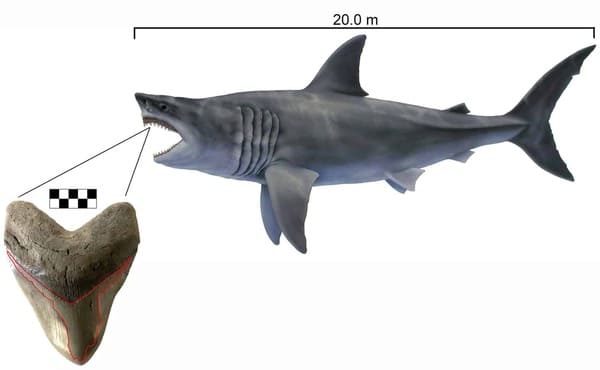
1. Megalodon (the animal with the strongest bite force found in the history of the earth)
In prehistoric times, the most powerful shark was recognized as the huge megalodon. They flourished during the Miocene period about 18 million to 2 million years ago. That period could be described as the golden age of the development of the shark family. The megalodon could reach about 19 meters in length and weighed about 70 tons. Its size was about three times that of the modern great white shark. These strong adult megalodons once swam in the boundless ocean and ate everything. They could prey on almost all sea creatures and were at the undisputed top of the food chain. It is understood that the megalodon has the strongest bite force known so far, which can reach 28 tons, making it one of the most terrifying predators in the history of the earth. It is generally believed that this terrifying creature went extinct about 2 million years ago.
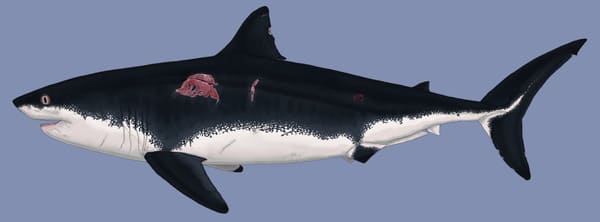
2. Cretaceous spiny shark (the largest shark during the Late Cretaceous period)
Among ancient giant sharks, the chalk-spined shark is one of the most frequently mentioned, ranking among the top ten giant sharks in ancient times. Because the shape of this prehistoric giant shark's teeth resembles a traditional Chinese kitchen knife, it is affectionately nicknamed the "golden chef shark". Although this name is widely circulated, it is not actually its official scientific name. Known as the "Cover of the Cretaceous", the Cretaceous spiny shark first appeared in the Late Cretaceous era 100 million years ago. Their average length is about 5.5 meters, the maximum can exceed 7.6 meters, and their weight is about 3.5 tons. Known for their speed and endurance, these ancient ocean behemoths would undoubtedly be among the ocean's apex predators in modern times. However, during its contemporaneity with the powerful mosasaurs, the chalk shark had to occupy the position of a secondary predator.
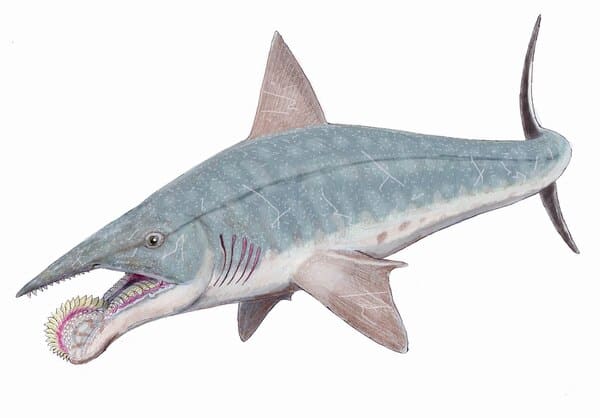
3. Helicoprion (an ancient cartilaginous fish that has long since become extinct)
As one of the top ten giant sharks in ancient times, Helicoprion is a mysterious marine creature whose unique properties still attract scientists to continue to explore. Helicopteron sharks have been studied for more than a hundred years. They existed in the prehistoric period about 300 million to 200 million years ago. The largest individuals could be more than 15 meters long. They were undoubtedly super predators in the ocean at that time. Their signature feature was a pair of huge spiral teeth. Next to his jaw. Since the discovery of Helicoprion, the scientific community has been conducting extensive discussions and research on the specific function and location of its helical teeth, because no species with such helical teeth has been found in extant sharks or other vertebrates. This unique helical tooth makes Helicodon an ongoing mystery in the study of prehistoric marine ecology.

4. ChubutOtodontooth shark
ChubotOtodontodon is one of the ten most famous sharks of prehistoric times, living from about 28 million years ago to 5 million years ago. Scientific estimates of the size of ChubotOtodon range in size: radical estimates put its length at 14 to 15 meters, while a more conservative and credible estimate is about 13 meters. The teeth of this shark can reach up to 129 mm long. It is famous for its powerful bite in the shark family, second only to the megalodon. They feed on large marine creatures such as turtles, seals and even whales. It is obviously the oldest in its period. The ocean's apex predator. However, Chubuteartodon's formidable enemies include other ocean behemoths, such as the megalodon and merinodon from the same period. Vitan whale. Later in its history, faced with increasingly fierce competition for survival and their solitary habits, Chubuteartooth sharks Gradually lost its advantage in this prehistoric survival war, eventually leading to the disappearance of its population.
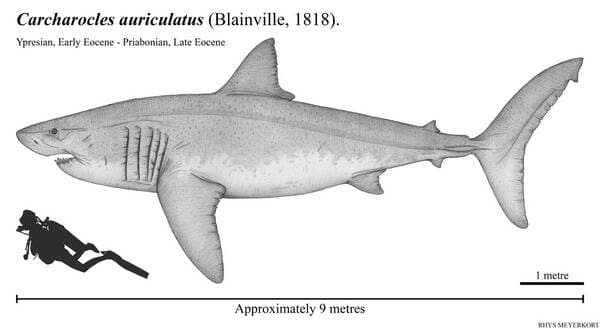
5. Otozoal shark
The otozoal shark, one of the most powerful predators among extinct sharks, dominated the oceans from 39 million to 25 million years ago, spanning the late Eocene to the early Oligocene. The body length of this kind of shark is usually about 8 meters, and some can reach 11 meters. In the marine environment of that era, the Aurochus shark was undoubtedly a giant, and its bravery was comparable to the giant predator in the ocean at that time, the Basilosaurus. They are evenly matched, and fierce competition for the top of the food chain often occurs.
However, with the appearance of the Megalodon, this even balance was broken. With its extraordinary size and attack capabilities, the megalodon gradually occupied the ecological niche of the otozoal shark. At the same time, the emergence of more powerful marine creatures such as the Shiga Sperm Whale further compressed the living space of the Otozoal Shark, leading to their eventual extinction. This shows that even the most powerful creatures may become dim due to changes in the environment and ecological competition.
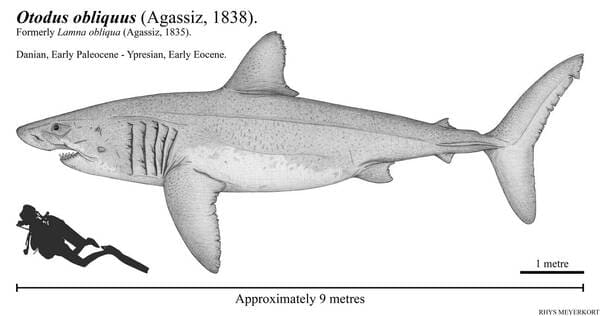
6. Platytodon shark
The platytodon is well-known among ancient sharks, especially in the late Cretaceous period, when it began to become a strong competitor in the ocean. Although mosasaurs still dominated the oceans at that time, the rise of the platyodont shark cannot be underestimated, with a length of about 10 meters. In its heyday, the largest individual of the platytodon shark could even reach 12.2 meters in length and weighed approximately 18 to 19 tons.
What's striking is the special structure of the teeth of Platylodon - the shark's tooth root thickness has an astonishing ratio to tooth height, ranging from one-third to almost half, depending on its location. Combined with its thick and powerful jaw structure, the bite force it can exert is enormous. Its sharp tooth tip design can easily penetrate the prey's flesh, and its thick tooth crown, supplemented by auxiliary small teeth on both sides, enhances its ability to capture prey. Once it bites tightly, the prey cannot escape its mouth. The optimization of this structure shows the strong character of the platytodon shark in the ancient food chain.
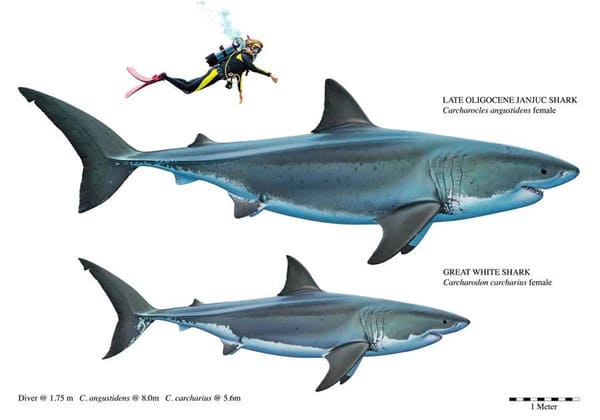
7. Angus Disha
The tooth fossils left by the Angusti shark, also known as the anthropod shark, are similar to the teeth of the modern great white shark, but their size is more than twice the size of the 7 cm long teeth of the great white shark. . Based on this feature, scientists speculate that the Anthropodus may be twice the size of the great white shark, with a length of up to 12 meters.
This ancient giant shark has a savage character, feeds mainly on cetaceans, and dominated the ocean world in the Oligocene Epoch. After Basilosaurus withdrew from the stage of history about 36 million years ago, Anthrophagus stentodon became the undisputed overlord of the ocean, and no other creature could compete with it in the food chain. Although the ancestral forms of baleen whales and toothed whales have appeared during the Oligocene Epoch, they were relatively small in size and were still dominated by Angusti sharks, often becoming the prey of this ferocious predator.
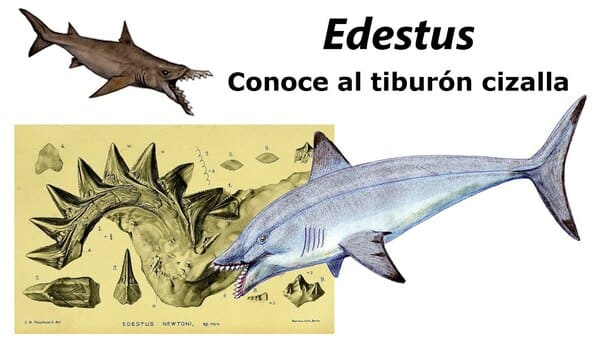
8. Greedy Scissor Shark
The greedy scissor shark (Edestus vorax) belongs to the extinct group of sharks, which caused me toA species of great interest. As a powerful carnivorous ocean ruler during the Paleozoic era, the greedy scissor shark has an astonishing body length, usually exceeding 10 meters. Even the smaller subspecies of the genus Scissors, such as E. minor, with a body size of about 5 meters, was at the top of the food chain in most areas of the ocean at that time.
The mouth structure of these ancient sharks is very special, as if they carry a pair of huge scissor-like teeth. Together with their huge bodies up to 10 meters long, they undoubtedly became super predators in the Carboniferous ocean. The voracious scissor shark not only preys on a variety of marine life, but also feeds on other sharks, demonstrating its dominance in ancient aquatic ecosystems.
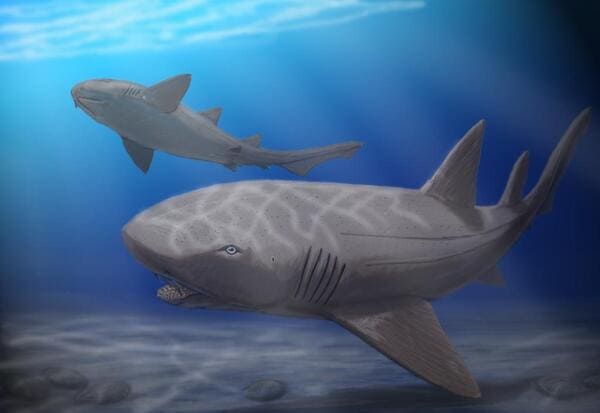
9. Morton's Wing Shark
The Morton's wing shark is an unusually large shark from prehistoric waters, known as the "shell crusher", mainly because of the unique structure of its teeth. This extinct shark showed very different characteristics from its ancient counterparts. Its teeth are round and thick, and the surface is covered with rich wrinkles. In its wide mouth, there are more than a thousand teeth, which are lined up like bricks. This combination of teeth, as well as the combination of them, The powerful bite force it can exert allows the winghead shark to easily hunt a variety of seabed creatures, such as shellfish, snails, ammonites and crustaceans, and can even crush hard turtle shells.
The back of the winged stigmata is not only covered with heavy scales, but also has sharp spines that can pierce flesh. This kind of armor allows it to protect itself in battles with predators in the ocean and deter pursuers in a timely manner. Although its appearance and abilities may conjure images of an aggressive creature, in fact, according to analysis of fossil records, the Morton's Winged Shark was a relatively docile creature, making it a distinctive ancient marine behemoth.
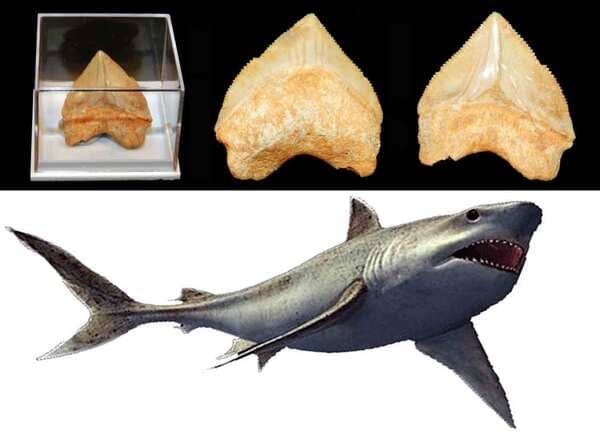
10. Sawtooth horned shark
The horned shark is an ancient shark from the Cretaceous period. Because their diet contains a lot of carrion, they are nicknamed "crow sharks". Within this genus, the Squalicorax pristodontus is a large species well known for its presence in Maastricht's world-class oceans. With a jaw that may be twice as long as that of a modern great white shark, the serrated horn shark is famous for its moderate build, savage character, sharp teeth, and agile movements. Its bite is powerful enough to easily break apart small land-dwelling sharks. Animal limbs.

The ranking of the top ten terrifying extinct sharks is mainly recommended based on the shark's popularity/predating ability and comprehensive reference to relevant Internet rankings/lists. This list is for entertainment reference only. The data is as of December 1, 2023. If you have any questions, please leave comments/criticisms at the end.
animal tags: shark
We created this article in conjunction with AI technology, then made sure it was fact-checked and edited by a Animals Top editor.